|
Commemoration of the Centenary of the
Declaration of the Great War
In order to
decide on the best manner by which the Parish of
Yarcombe should commemorate the centenary of the
outbreak of the Great War, it is necessary to
remind ourselves as to how those who were more
immediately involved decided to recognise those
who gave their lives in the conflict.
In the Baptist
Chapel there is a wall plaque made of carved
wood into which has been set three brass plates, the heading of which reads:-
“To the Glory
of God & in honour of those connected with this
Church & Parish who served in His Majesty`s
Forces during the Great European War”
Two plates list
those who served in the Armed Forces and the
third central plate records “Our Brave Dead” who
are listed as follows:
|
Batten T |
Hawkins WT |
|
Bachelor TJ |
Hooper C |
|
Bond EJ |
Spiller FB |
|
Bibbs EJB |
Wakely W |
|
Collins H |
Willie JH |
|
Doble H |
|
In St John
Baptist Church, set behind the south door on the wall are to be found three
ceramic tiles on which the following names
of those who gave their lives are
recorded:
|
John T Bachelor |
RGA |
|
Tom Batten |
Ox and Bucks Light Infantry |
|
Ernest Bond |
Royal Enniskillen Fusiliers |
|
Henry Collins |
Somerset Light Infantry |
|
Henry Doble |
Devonshire Regiment |
|
Walter T Hawkins |
Devonshire Regiment |
|
Fred B Spiller |
AIF |
It is
immediately
apparent that the Baptist
Chapel records eleven of the fallen whilst
the Church records seven, the reason is
apparent from the inscription in the Chapel
“…those connected
with this Church and Parish…”
In the hunt for
more information about those brave men who gave
their lives, Mary Smith kindly gave me access to
the Minute Book of the Parochial Church Council
from that time, and whereas not much real
information can be gleaned, in the Vestry
Minutes of Easter 1916 we have the following
entry:
“Mention was also
made that the names of those who gone to war
should be recorded in the minute book and an oak
screen be put up in the Church as a War Memorial
with their names inscribed on it”.
| George
Bennett |
4th Devons |
| Samuel
Culverwell |
RAMC |
|
Reginald Culverwell |
RAMC |
| Sidney
Doble |
RU |
| James
Doble |
4th Devons |
| Joseph
Doble |
4th Devons |
| Walter
Hawkins |
3rd Devons trfd to 1st
Devons |
| Ernest
Phillips |
SLI |
|
Reginald Pring |
Yeomanry |
| Alfred
Purse |
SLI |
| Walter
Wakley |
SLI |
·
In the minutes
for April 1919 there is the following entry:
“It was decided
to put a brass plate in the church with the
names of those who have fallen and a printed
list framed of those who served their country
during the war”.
From the above
War Memorials we are already beginning to find
the names of those who gave their lives, their
first names and initials and the name of the
unit in which they served. From this information
we may be able to find out more about the
service career of each of these soldiers. I will
undertake the necessary research during the
coming year and I would be extremely grateful of
any information, photos, memories that may still
be available from members of families who are
still resident in the area.
When I mentioned
this project to Brian Smith he drew my attention
to a grave that lies to the left of the path as
you approach the south door of the Church which
he stated was still maintained by the War
Department. The gravestone commemorates Ernest
John Bond of The Royal Enniskillen Fusiliers who
died in Exeter on 17th May 1919; from
the Commonwealth War Graves Commission, who is
the body who still maintains this gravestone, I
discovered Ernest was the son of Jesse George
and MA Bond of Grovewell Cottage. I will provide
more information about Ernest Bond later in this
article.
However on the
morning I visited the churchyard to examine this
gravestone I met John Salter and he told me the
following fascinating piece of information:
“The original
village war memorial was in the form of a wheeled
funeral bier, however this proved not to be the
most practical because it could not be
manoeuvred down the steps in the churchyard, so
in about 1950 the incumbent Rev Clough took it
to the Vicarage for storage, it was never to be
seen again. But there is a tale within a tale, Mr
Clough was man of private means and when the
Socialist Government came to power in 1948
decided to emigrate to New Zealand and shipped
himself and his motor car, a Humber Snipe, off to
the Antipodes. The car was on another ship and
when it arrived the Customs wanted to charge
£500 duty. Mr Clough did not take kindly to this
request so he shipped his family and car back to
the UK and took up his position once again in Yarcombe!”
It would appear
from this information that the Village after the
conflict decided to have as a War Memorial a
piece of equipment that not only would serve as
a fitting Memorial to the Fallen but would also
serve a practical purpose.
Firstly we need
to establish if there are any records of this
bier; and it may explain why the Memorial in the
church is a low key monument. In any event one
suggestion made at this month’s meeting of the
Parish Council is that perhaps a model be made
of this bier and that it should be preserved in
a fitting place in the Church.
The first person
who has contacted me with information about one
of our Glorious Dead, is Elaine Munt who lives
at Hay Bungalow. Elaine very kindly came to tea
with Susanne and myself and brought with her a
photograph, taken outside Lower Waterhayne Farm
of the Bibbs family taken in a 1910 or
thereabouts, all in their Sunday best, one
amongst which is identified as Ernest John
Benjamin Bibbs aged about twenty. Sad to record
this young man was killed on 10th
November 1918 at Hestrud in Belgium whilst
serving with the Machine Gun Corps. He was born
in Yarcombe in 1887, the son of Robert Henry Bibbs and Mary Jane (nee Mathews). From the
census records we assess that this Bibbs family
must have moved to Birmingham in about 1895,
where the family raised yet more children and
where Robert Bibbs worked as a coal agent. From
his medal card we learn that Ernest Bibbs
enlisted in the South Notts Regiment in 1915 and
was sent to France in September 1915, he later
transferred to the Machine Gun Corps and at the
time of his death was a sergeant.
As a final note
to this first article I referred above to the
grave of Ernest John Bond whom we suspect may
have been a prisoner of war and was repatriated
to Exeter where he died in 1919. This man was the
son of Jesse Bond who was born in Stockland and
in 1911 was living at Birch, Yarcombe with his
wife Mary Ann and their 6 children.
His
occupation is listed as Parish Relief and is, I
suspect, not related to the Bond family who lived
at North Waterhayne at that time.
| Key
to Abbreviations |
| |
| RGA
Royal Garrison Artillery |
| |
| AIF
Australian Infantry Force |
| |
| RAMC
Royal Army Medical Corps |
| |
| SLI
Somerset Light Infantry |
| |
| RU
Possibly Release Unit or Ram Unit
|
These are early
days, I still have to research the Minutes of
the Parish Council and I am hoping Thelma Clarke
may find the minutes of the Baptist Chapel.
Please, if anyone has any information or ideas as
to how we as a Parish might commemorate this
centenary please contact me.
Steve Horner
steve@horner.uk.com
01460 234 342
HARRY DOBLE
This item very kindly supplied in January
2022 by Chris Salter - see
Ancestral Search 71
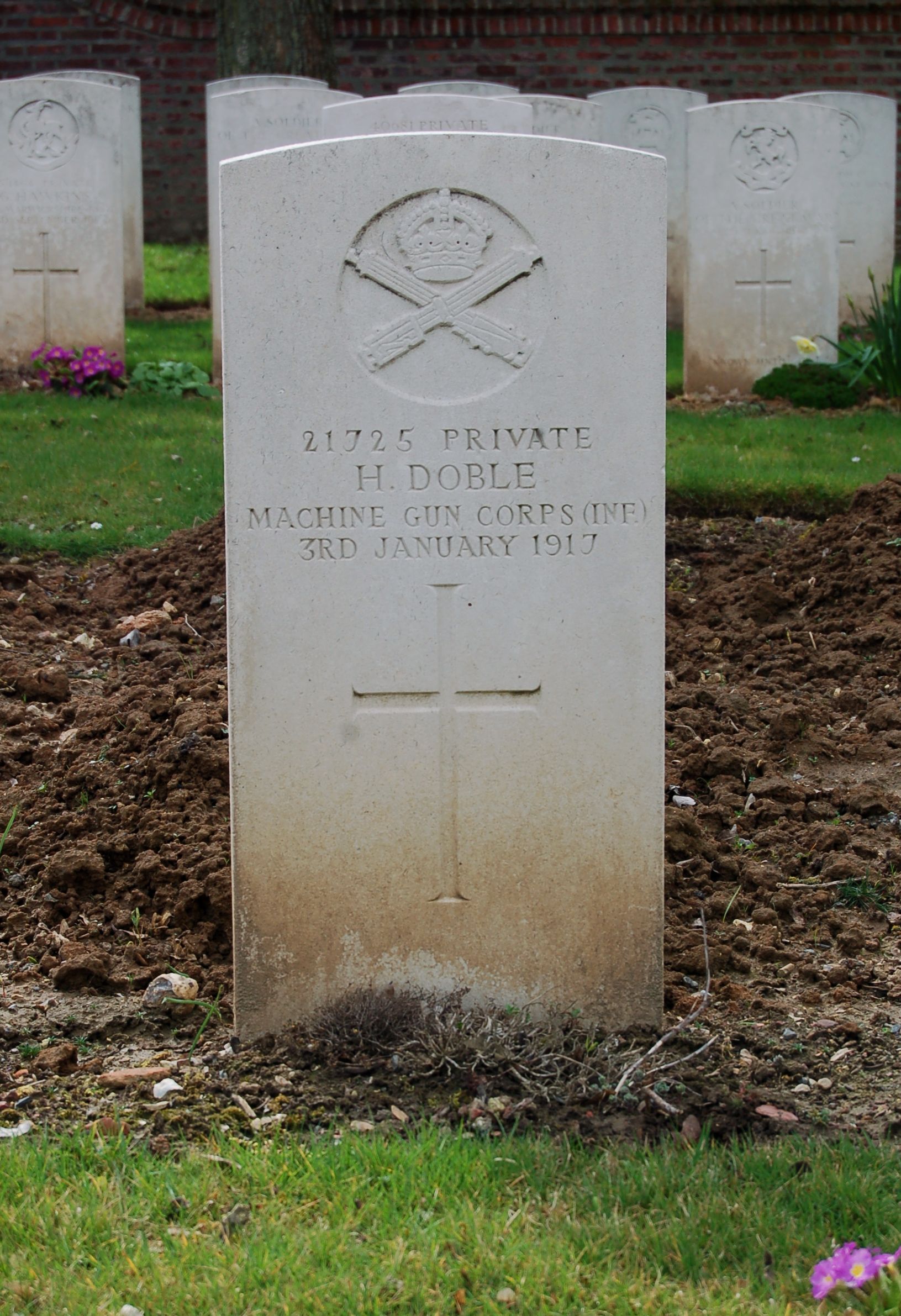
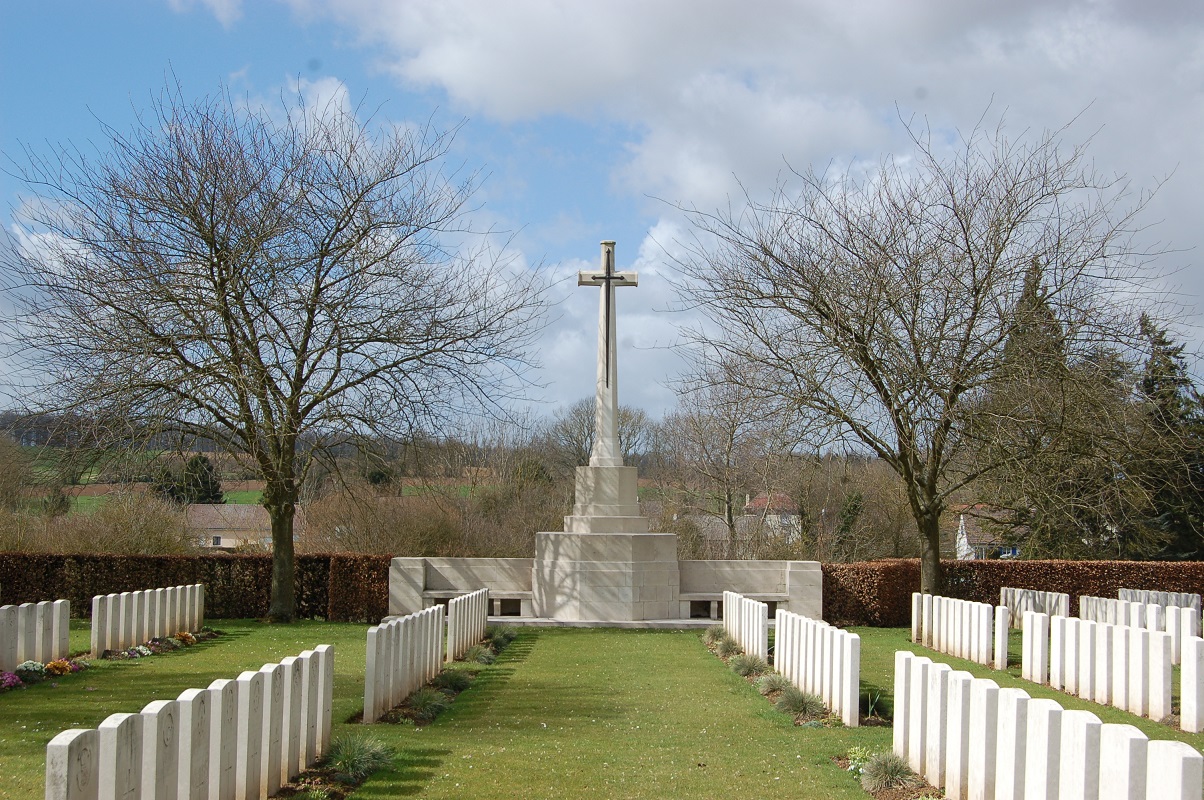
Harry Doble (1888-1917)
Harry Doble was born in Yarcombe on 27 June
1888, the fifth son, and seventh child, of
James Doble and his wife Mary Jane (née
Sprague), who were living at Rower Cottage,
Yarcombe, having married at Yarcombe on 16
November 1876. The register for
Yarcombe Primary School (Devon Heritage
Centre ref 1453C/EFA1) shows Harry was
admitted to the school on 15 May 1893
(admission no. 841 in the register) and left
on 19 January 1900. In November
1906 Harry enlisted in the Devonshire
Regiment claiming to be aged 19 years and 6
months, whereas he was in fact a year
younger than that. The records
show however that just six weeks later, in
January 1907, he bought himself out.
The reasons are not known.
On 31 May 1909, Harry married Minnie Ethel
Rockett (1888-1966), a first cousin of my
mother, in St Michael’s parish church at
Musbury, which was Minnie’s birthplace.
Their first child was a daughter, named
Phyllis Eva Mary, born later that year
whilst they were living at Bealey [Bewley]
in Chardstock parish. The census
taken on 2 April 1911 shows Harry and Minnie
were then residing at Peterhayes Cottage in
Yarcombe, with Harry employed as a horseman
on the farm. Their second child,
a son named Stanley James, was born at
Honiton in December of that year.
On 11 December 1915 Harry volunteered for
enlistment at Axminster under the ‘Derby
Scheme’ and joined the 3rd Battalion
Devonshire Regiment (a training unit then
based in Devonport). Eighteen
months later, on 16 July 1916 Harry embarked
from Southampton for the BEF in France, and
on 24 July he joined the 2nd Battalion
Devonshire Regiment (part of the 23rd
Brigade, 8th Division) at Cuinchy, about 20
miles south-west of Lille. The
8th Division (including the 2nd Devons) had
recently seen major action. On 1
July 1916 (the first day of the ‘Somme
Offensive’ - the deadliest day in British
military history) the 2nd Devons had
suffered very heavy casualties at ‘Mash
Valley’, a scene of carnage, and as a
consequence had been taken out of the line
to rebuild. By 7 July the 2nd
Devons had been moved north away from the
Somme sector to Barlin where they received a
draft of 92 other ranks to fill some of
their gaps. A week later they
entered the trenches at Cuinchy near
Bethune. It was here on 24 July
that Harry, along with three officers and 25
other ranks, joined the 2nd Devons as much
needed reinforcements. After
Harry had joined them, the 2nd Devons
remained in the sector near Cuinchy until 14
October, when they moved back south to the
Somme sector, arriving at Meaulte near the
city of Albert on 17 October.
Harry’s service record shows that the
following day, 18 October, he was attached
to the 23rd Machine Gun Company (MGC).
This was a specialist unit that belonged to
the 23rd Brigade as a whole rather than to
any individual infantry battalion.
The 23rd MGC’s war diary for 18 October
shows “48 men attached from battalions” and
Harry would have been one of them.
Harry’s service record shows that on 31
December he was officially transferred to
the Machine Gun Corps (23rd Company) but
just three days later, on 3 January 1917, he
was ‘killed-in-action’. The
circumstances of his death however are
something of a mystery.
According to their war diary his unit, the
23rd MGC, was ‘in the field’ near the
village of Combles (about 10 miles east of
Albert) from 29 December 1916 until 10
January 1917, and spent most of their time
during that period improving positions by
working on trenches and dugouts etc.
Also, it appears they did not engage the
enemy during that time, although there was
some shelling by the enemy on the nights of
2 and 5 January. There is no
mention in the diary of any casualties
during that period. On 3
January, the day Harry was reported as
‘killed-in-action’, his unit’s diary
recorded “Situation normal.
Targets engaged nil” with no mention of any
enemy shelling. A further check
of the war diary of the 2nd Devons, Harry’s
original battalion, similarly showed no
record of any casualties on or about 3
January. How Harry came to lose
his life that day is therefore unclear.
Whatever the circumstances were surrounding
his death, Harry is buried in Combles
Communal Cemetery Extension in the village
of Combles in northern France, and ‘Harry
Doble of the Devonshire Regiment’ is
commemorated on the memorial inside the
parish church in his home village of
Yarcombe. There is also a
memorial to the 15,552 wartime fatalities of
the Machine Gun Corps at Hyde Park Corner in
London.
Photos/Records
...
Included are various photos/records relating
to Harry, viz:
|
Service records for 1906-07 |



 |
|
Service records for his
war-time service in 1915-17 |














 |
|
Medal
card & relevant page from the
Machine Gun Corps Medal Roll |

 |
|
CWGC records for Harry’s grave and its
headstone inscription |

 |
|
Commonwealth War Graves
Commission Certificate of Honour |
 |
| |
|
.jpg) |
.jpg) |
| |
|
|
Two postcards of Combles showing the
extent of the village’s destruction in 1916 |
FREDERICK B SPILLER
Here is a link to the grave of Fred Spiller
on the findagrave website
THE BATTEN FAMILY

Above: Memorial Stone in the
Baptist Chapel Yarcombe
|
|
John Batten.
Died in South Africa 30-12-1900.
Born 1879 son of Eli and Mary Jane
Batten served with the Somerset Light
Infantry in the Boer War.
Died of disease Springfontein 30/12/1900
He is buried with
Mary
Jane Batten
Died
27-01-1910. Nee Corner born
9/10/1849 Tiverton. Married
Eli Batten
1875 Eli and Mary Jane had seven
children.
Eli Batten
Died
18-04-1924 born 25/01/1846 Whitestaunton
Thomas Batten.
Died in France 23-03-1918.
Brother of John.
The record states that
the latter 2 are buried with John and
Mary Jane. In my opinion not
possible as it was customary for those
killed in action to be buried where they
fell. I assume Eli and Mary
Jane wanted to commemorate their two
sons who fell in action.
Nora R M Batten
Died 21-02-1922 As yet I cannot trace
this lady.
Robert Batten
Died
16-05-1937 at Membury (1878-1937).
Brother of John and Thomas.
Married Lucy Jane Doble
(1879-1967).
Buried with:
Lucy Jane Batten
Died May 1967 (wife of Robert).
Samuel Batten
Died
in Exminster (1882-1956).
Brother of John and Thomas.
Married Elizabeth B Doble and buried
with
Elizabeth Bessie
Batten (wife of Samuel) who died in
Ottery St Mary 16-10-1963.
|
|
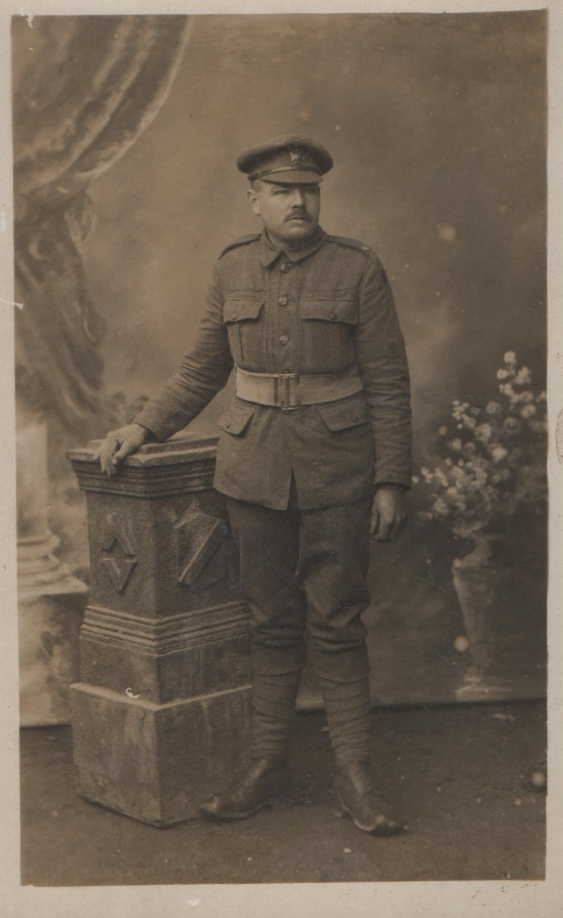 |
Left: Thomas Batten
Right: Thomas Batten's "Dead
Man's Penny" Plaque
(click to enlarge) |
|
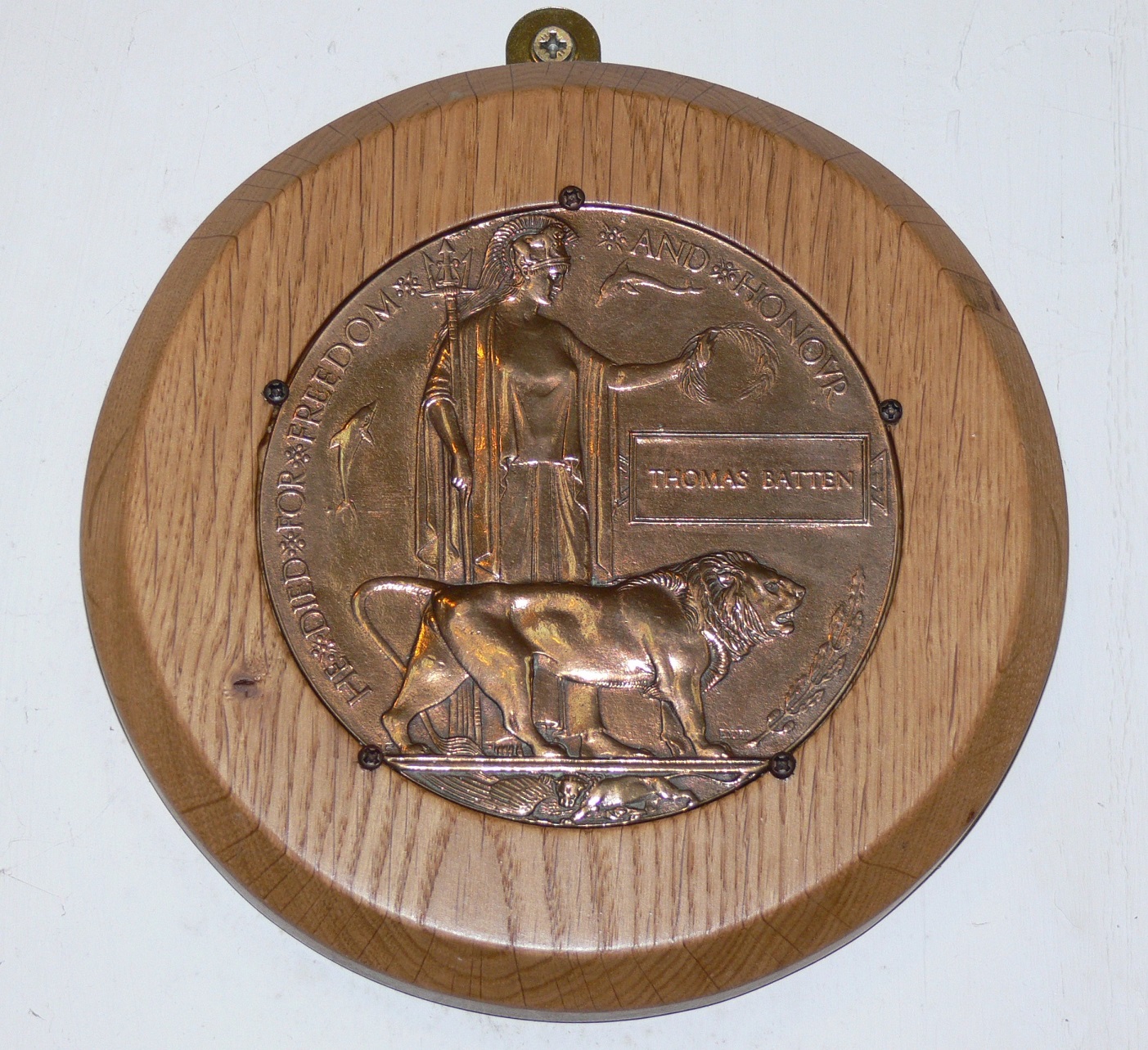 |
|
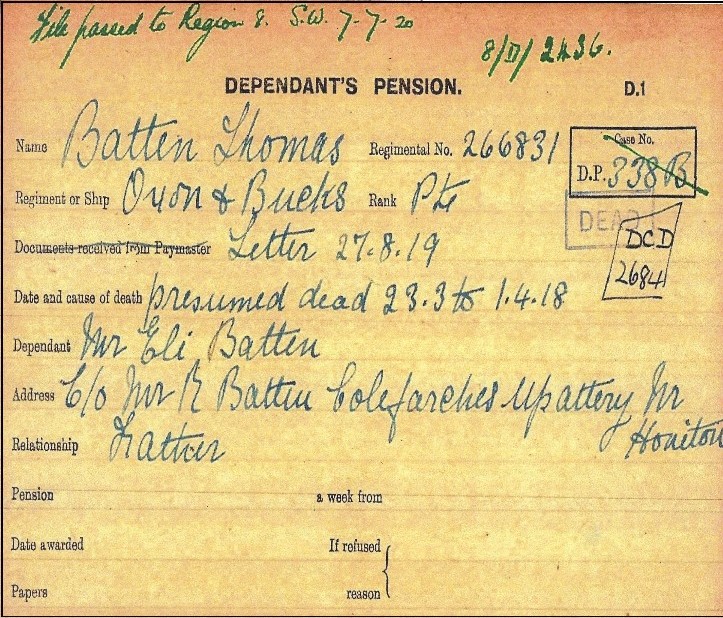 War
Diary:

See
Ancestral Search 66
for more information
|
The resting place of
John Batten. Died in South
Africa 30-12-1900. Born
1879, son of Eli and Mary Jane Batten;
served with the Somerset Light Infantry
in the Boer War. Died of
disease Springfontein 30/12/1900. |
|
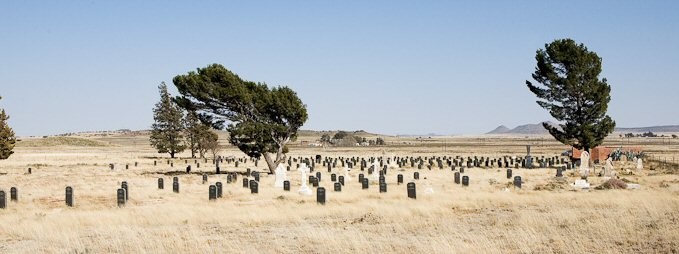 |
|
| |
|
Springfontein |
|
JOHN HURFORD WILLIE
|
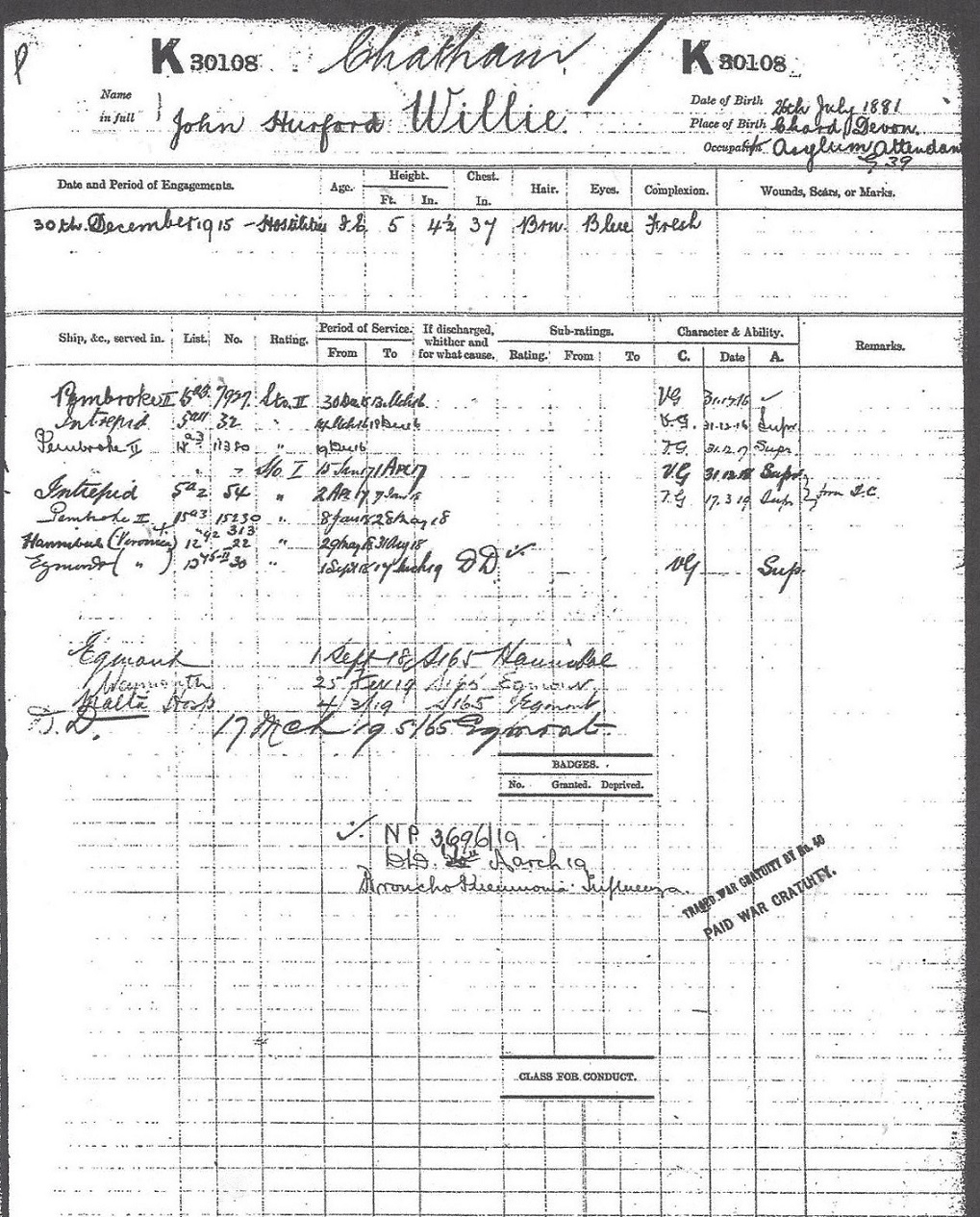 |
|
 |
|
|
Service Record |
|
Grave |
|
|
(Click
for larger images) |
|
|
Thanks to Will Rich for this
certicate (right) from the Mayoress
of Exeter:
This Great war certificate was for my
great grandmother who actually was
living at Sutton Barton until 1919,
so does not relate to Yarcombe.
Will Rich
See
Ancestral Search 72 for more
from Will |
|
 |
Remembering The Armistice
The following articles
appeared in the December 2018 edition of Yarcombe Voices
BEACON:
On Sunday evening at seven o’clock, after much
preparation leading up to a weekend of
commemoration and celebration and like many
other communities throughout the country, Yarcombe lit its own Beacon. It was
a clear night with a new moon and in a prominent
position just below the phone mast with a view
down the Yarty Valley. Those who
witnessed the occasion including David and
Nicola Meyrick were not disappointed as the dry
wood rapidly caught light and the wind fanned
the flames. Some had already lit
their fires before coming to see the Beacon and
others were soon off to view neighbouring
bonfires. Thanks to David and Nicola
for allowing the use of the field and to Steve
Horner who had a beacon-basket made previously
to the pattern of one commissioned for ‘Fires
over England’ in 1988, our elevated flames
joined the others we could see on the
surrounding hills and in the valley below us.
Apologies to those who turned up after the
Beacon fire died down, but our village website
will be displaying a number of photographs of
the event. (See below)
BONFIRES: Our thanks go to the people who
hosted each of the 11 bonfires on the 11th day
of the 11th month, one for each of the Fallen in
our Parish. The bonfire at Four
Elms, where Thomas Batten is remembered
on a headstone and by the ‘Dead Man’s Penny’ in
the adjacent Baptist Chapel, was hosted by Nick
Randle and Thelma Clarke. Debbie
Luck and family were at this bonfire.
This bonfire would also have been seen from Stockhouse, where
Walter Tom Hawkins’
family lived, according to the 1911 Census.
On the other side of the ridge which runs along
Pound Lane, Lorna and Jim Burdge and family had
their bonfire at South Waterhayne.
This is where the family of Ernest Bibbs’
mother farmed, particularly poignant is the fact
that he died on November 10th 1918, just a day
before the Armistice. Thanks to
Elaine Munt we have a photograph of Ernest Bibbs
and he was also commemorated by Andrew and
Elaine. At the end of Pound
Lane, George Pidgeon was also having a bonfire
as was Jean Rich at Broadley Farm just up the
lane from Grove Well Farm where Ernest John
Bond’s family lived. Just after
7p.m., Philip, Barbara and James Bearne from
Waterhayne Cottage went up James Lane and were
able to see nine of the bonfires from there.
Thomas Batten was also being commemorated at the
Beacon, where Tommy had lived and where his Dead
Man’s Penny would have been a treasured
possession of his family for many years.
We do not know its travels before it was
returned, out of the blue, to Yarcombe in 2016.
Maggie Tomkinson was joined by Miranda Gudenian,
Caroline Ford and Paul and Nicole Dunphy.
(It was at this moment that I was lucky enough
to spot two shooting stars arching over the
valley. - Ed.). At Peterhayes the
Derryman’s bonfire was in the location of
Harry Doble’s family home as recorded in the
1911 Census. There were also
bonfires at Valley View where Daniel Greening
and Alistair Billington ensured that it could be
seen down the Yarty Valley as did Merv Edgecombe
at Cornhill, which may have been the largest
fire and the longest in flame. There
were also bonfires in Marsh. One of
them was at Knightshayne Farm where David Barnes
positioned it so that it could be seen down the
valley towards the village. This
bonfire was the one closest to where Charles
William Hooper lived with his family in
Sudbeer, a property which has now disappeared,
but was between Williambeer Farm and Watchford.
It was also the closest to Stout Cottages where
Harry Collins, the first person in the
Parish killed in the war, lived in the 1911
census. Steve and Susanne Horner
positioned their bonfire at Old Woodhayne Farm
at the highest point in the Parish which has a
clear view across the valley to the Howley
Tavern. Even Golden Cap can be seen
in the distance on a clear day, while behind
them the lights on the Stockland TV mast were
visible. They could also see their
neighbours' bonfire - Phil and Gill Holness and
family - at Shorthayne, where a ‘Lest We Forget’
flag featuring a poppy and five aircraft.
As Steve and Susanne gazed down into the valley
they could see the fire at Shorthayne and
another at Southey and they realised that 100
years ago there would have been no lights
visible in the valley. As Woodhayne is remote
they pondered how the occupants of their farm
and others similarly remote in those far off
times found out the news of the Armistice on
that momentous day as they would not have been
able to hear the bells of either Yarcombe Church
or Buckland Church. Perhaps news of such great
significance was passed from neighbour to
neighbour and wherever they lived, they quietly
celebrated the Armistice in their own way.
The Beacon itself was only a hundred yards or so
from Smokey House, home in 1891 to Frederick
Spiller whose parents were living at 1
Calways in the 1901 Census. John
Batchelor who was a gamekeeper on the
Yarcombe Estate would have been familiar with
the land around the Beacon. Another
bonfire on the Estate was at Panshayne where
Philip and Serena Kerr saw their fire lit and
then left the family in charge while they came
up to the Beacon. We are
particularly grateful to Steve Horner whose very
thorough research into the eleven Fallen
recorded on the Roll of Honour has enabled
Yarcombe to bring very special personal details
to many of these names and link them to their
‘own’ bonfire tribute.
CANDLES: Thank you to everyone who lit
candles in their windows and turned out the
lights at 7p.m. Phil Holness placed
his candle beside a treasured family photograph
of his grandfather George, in uniform surrounded
by his wife and seven children, including Leslie
who was Phil’s dad. The occasion
appears to have been while he was on leave
during what turned out to be four years serving
in the trenches, which he survived, to return to
his family and have a further five children.
Together, these tributes, all on Armistice
Sunday evening, were a special Yarcombe
commemoration of the determination, bravery and
sacrifice by so many men and women, and
especially our eleven, now remembered 100 years
later, not just in the Church, the Baptist
Chapel and the Jubilee Hall, but at various
places throughout the Parish, many directly
linked to our eleven gallant soldiers, but all
bonfire locations would most probably have been
familiar to each and every one of them.
Clive
Stone
On Sunday 11th
November at exactly 7p.m., Susanne and I lit our
bonfire on our top field which we believe is the
highest point in the Parish. From
this site we can see Golden Cap down on the
coast and the top light of the Stockland TV
mast; sadly we cannot look down the valley but
we do look across to Howley and the Turnpike
Caravan Park. I timed my lighting
procedure with the aid of the clock on my mobile
phone, a device unknown 100
years ago and our Beacon was soon burning
brightly; it is amazing how a bale of straw and
pallets soaked in diesel will quickly produce a
fire giving off great heat and much light which
should have been visible from many miles away.
We had our backs to the south-west wind and the
sky above was clear, behind us a crescent new
moon waxed brightly on the western horizon and
above loomed the red planet, Mars the God of war
- was this a portent I asked myself? As we
gazed down into the valley we could see a fire
at Shorthayne and another perhaps at Southey and
Susanne commented that 100 years ago the valley
would have been peaceful and no lights would
have been visible. As we are remote
here at Woodhayne we pondered how the occupants
of the farm in those far off days found out the
news; we cannot hear the bells of Yarcombe
Church though with an easterly wind we do hear
the peal of Buckland Church. Still,
perhaps news of such great significance was
passed from neighbour to neighbour and indeed
those who lived here also quietly celebrated the
Armistice. We returned downhill to
our cosy, warm house and watched the most moving
of TV programmes, 'They Shall Not Grow Old'
produced by Peter Jackson which brought home
with terrifying reality the horror, noise and
stench of war. Well done to Maggie,
Clive, Miranda and many others in our community
who worked tirelessly to make this a memorable
Armistice Day when we were all able to honour
all those from our Parish and indeed the country
who gave so much that we could be free today.
Steve Horner
Yarcombe people were busy during
the week preceding Remembrance Day.
Sonia Boyd’s Flower Fairies beautifully
decorated the Church and another team of
volunteers put up bunting and flags inside and
outside the Jubilee Hall (the entrance now
embellished with Peter Meyrick's beautiful new
railings in memory of his great uncle who was
killed in the Second World War).
Therefore the monthly Village Market on Saturday
10th was set in the mood for the celebrations
and Rebecca Bell and Diane Frost went the extra
mile to make Anzac biscuits and Trench cake for
refreshments for the many who braved the
elements to attend. In the afternoon
tables were set out in long rows in the hall to
emulate an indoor street party for the evening
entertainment and bedecked with candles,
poppies, menus for the forthcoming feast and
information about food rationing which occurred
as supplies dwindled in 1918. It was
interesting to note that people were urged to
use potatoes freely! (Street parties
started in the First World War to help feed
children as food was so scarce).
Maggie Tomkinson had been busy with her team
organising this Yarcombe and Marsh 'Thank You
100' Indoor Street Party, where everybody was
encouraged to dress up in WWI costume.
Service uniforms, hats, long skirts and blouses
were raked out from the back of wardrobes
confirming the old adage that what goes round,
comes round! Philip Kerr, compere
for the evening, proposed a toast to ‘Peace’ and
got everybody into the swing of things by asking
Maggie Lane to play the National Anthem, first
to ‘God Save the King', and then to 'The Queen’.
Streeters were in charge of doling out the first
course of beef stew, brimming plates being
passed down the tables and mopped clean with
bread. Second and third helpings
were available to those who could manage them.
Then there was a break for Maggie’s Mix and the
Allsorts to sing and encourage all to join in
those well known songs, ‘Pack Up Your Troubles',
'It’s a Long Way to Tipperary', 'You Made Me
Love You', 'Silvery Moon', 'Roses are Blooming
in Picardy', from the song sheets provided.
It was also time for the raffle to be drawn,
with prizes such as a tin of spam or a candle,
so precious in WWI. The second
course, apple cake and custard was then served
during which a themed quiz was introduced by
Philip, diners dividing themselves into smaller
groups around the tables. Some very
obscure questions were asked, some with answers
to choose from, and others which meant trying to
apply a little logic, which proved both
informative and interesting. Winning
groups receiving Cadbury’s chocolate bars, after
all had joined in a bit more singing to bring
the evening to a close. Those who
attended would like to thank Maggie T for
arranging such a thoughtful and enjoyable
evening. Luckily, Sunday 11th dawned
bright and sunny. The Church bell
ringers muffled their bells prior to the
service, and rang clear after the service.
It was a great joy to welcome Joan Berry back to
take the service which is so dear to her heart
and to see her on the road to recovery.
She was assisted by Thelma Clarke from the
Baptist Chapel whose wonderful support both
mentally and physically were apparent.
Chard Concert Brass, faithful over very many
years, played the music for the hymns; the
bugler played Last Post and Reveille.
The Colour Party was led by Flag bearer George
Bright and wreath bearers were Benjamin Rich,
Emma Dyer, Caroline Ford, David Clarke, Rosemary
Abel and Geoffrey Berry. Organist,
Gavin, read the names of the fallen from
Yarcombe. Ex Sgt. (M.P) Nicholas
Wadey read the Commendation and Kohima Epitaph.
Miranda Gudenian read 'A Horses’s Prayer' and
spoke about the eight million horses, donkeys
and mules killed and mutilated on the
battlefields of World War One, such dreadful
conditions; the prayer was a favourite of the
late Michael Ford, Chairman of the Membury &
Yarcombe Branch of the Royal British Legion, who
had contributed to the Remembrance Service over
so many years. David Tyzack read the New
Testament lesson. Joan Berry gave the Address
and Thelma Clarke read prayers. David Bristol
and Henry Derryman were sidesmen.
Refreshments were served in the South Transept
after the service by Barbara Salter, Rebecca
Bell, Mary Smith and Margaret Hoare.
During this social break Gavin played WWI songs
on the organ. At 7p.m. that evening,
organised by Clive Stone and in unison with the
rest of the country to commemorate the signing
of the World War One Armistice, a beacon was lit
in the field at the site of Yarcombe’s beacon by
kind permission of David and Nicola Meyrick.
Eleven smaller bonfires were lit around the
village and candles placed in darkened windows
at the same time in memory of the eleven men
from this Parish killed in the First World War.
Lesley Sutton
Here
follows a collection of photographs taken of the
Yarcombe beacons on 11th November 2018, on the
100th Anniversay of the Armistice:
(Click to
enlarge in a separate window)
| |
|
|
|
| |
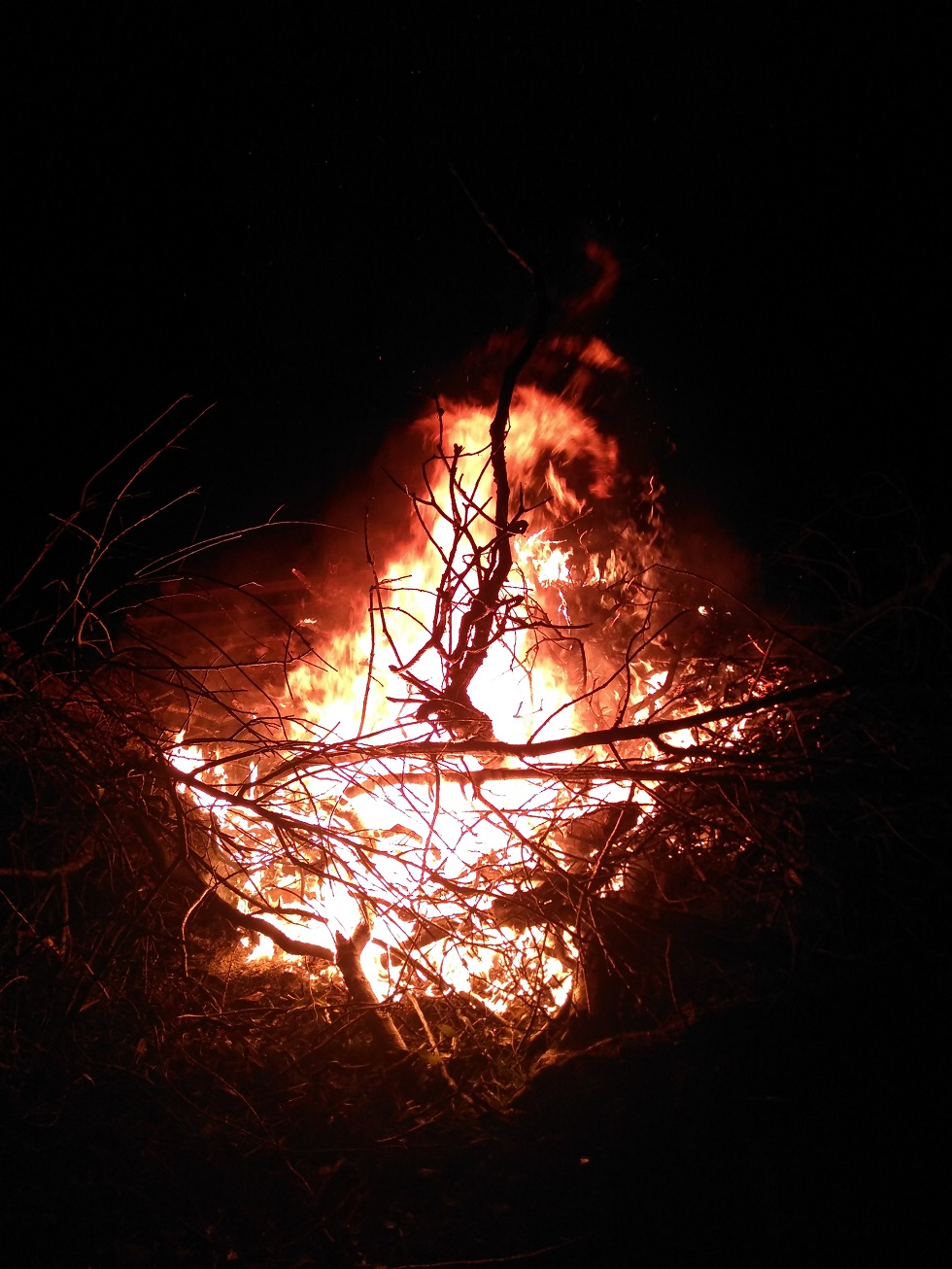 |
|
South Waterhayne
(Lorna & Jim Burdge)
Ernest Bibbs
remembered |
| |
|
|
|
| |
Picture
not available |
|
Visible from
Grovewell where Ernest John Bond's
family lived (Jean Rich) |
| |
|
|
|
| |
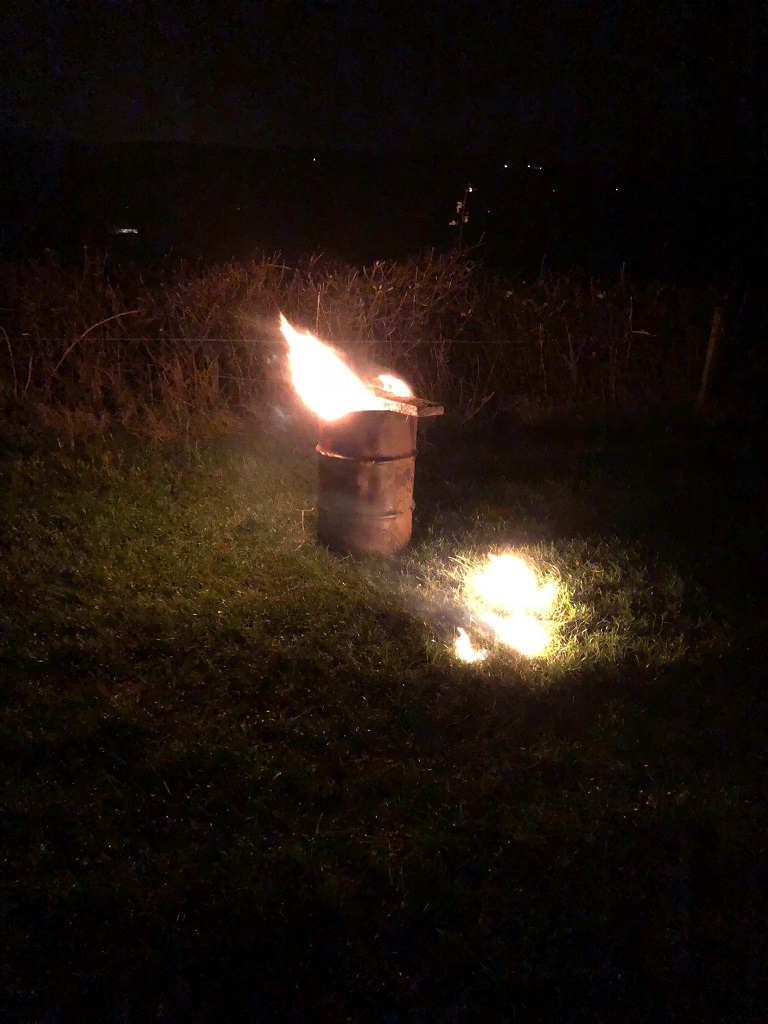 |
|
Peterhayes Farm
(The Derrymans)
Harry Doble
remembered
|
| |
|
|
|
| |
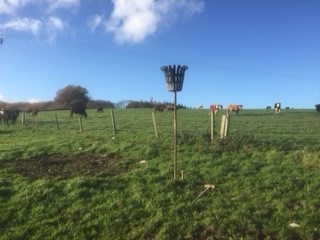 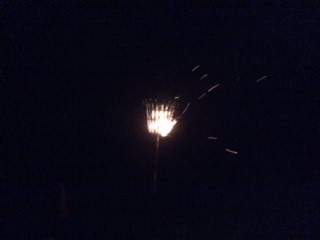 |
|
This
location would have been very familiar
to Frederick Spiller who lived in Smoky
House 100 yards down the road and to
John Bachelor who was a game keeper on
the Yarcombe Estate |
| |
|
|
|
| |
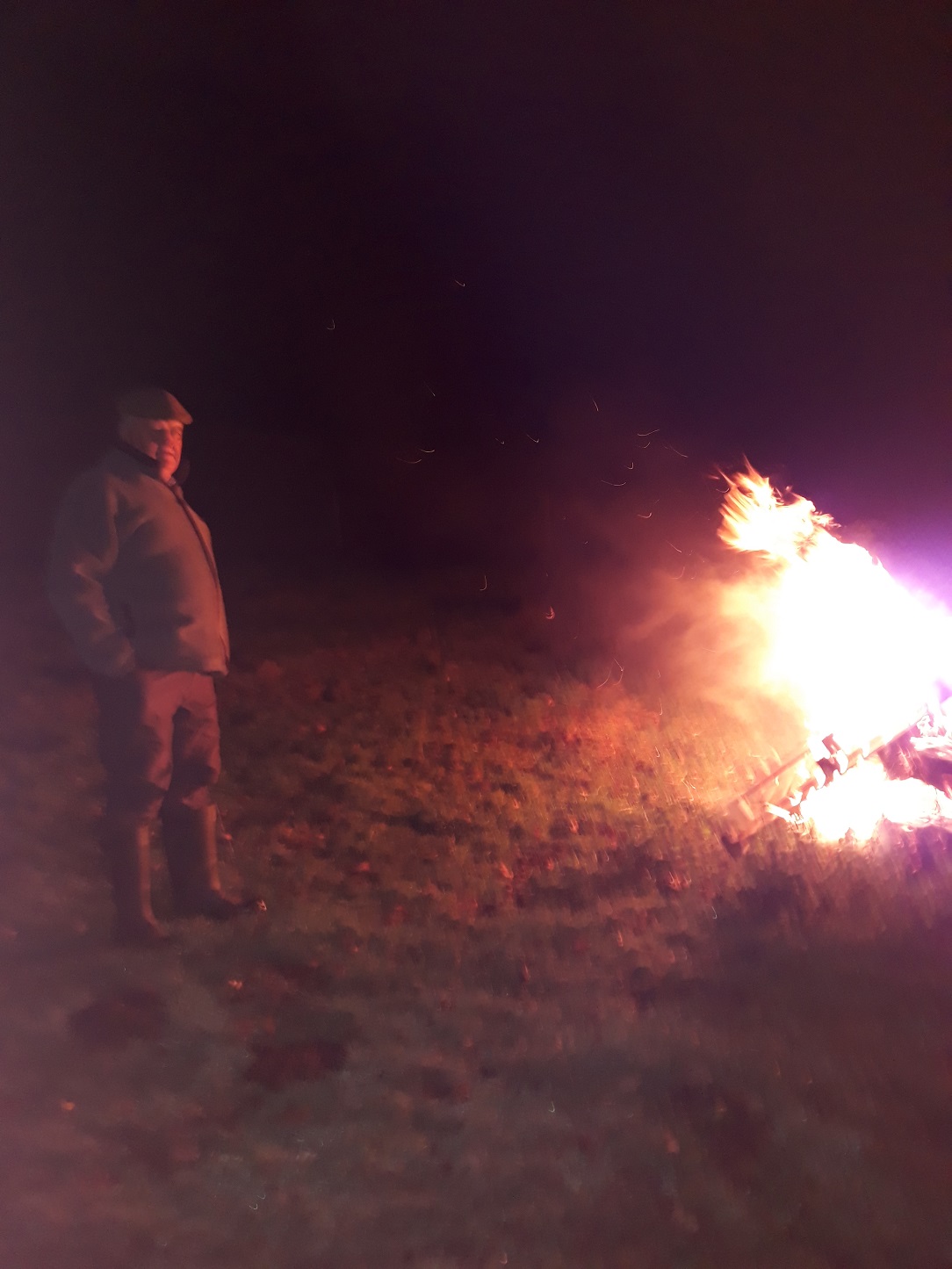 |
|
Old Woodhayne Farm
Highest
point in the Parish
(Steve and Susanne
Horner)
|
| |
|
|
|
| |
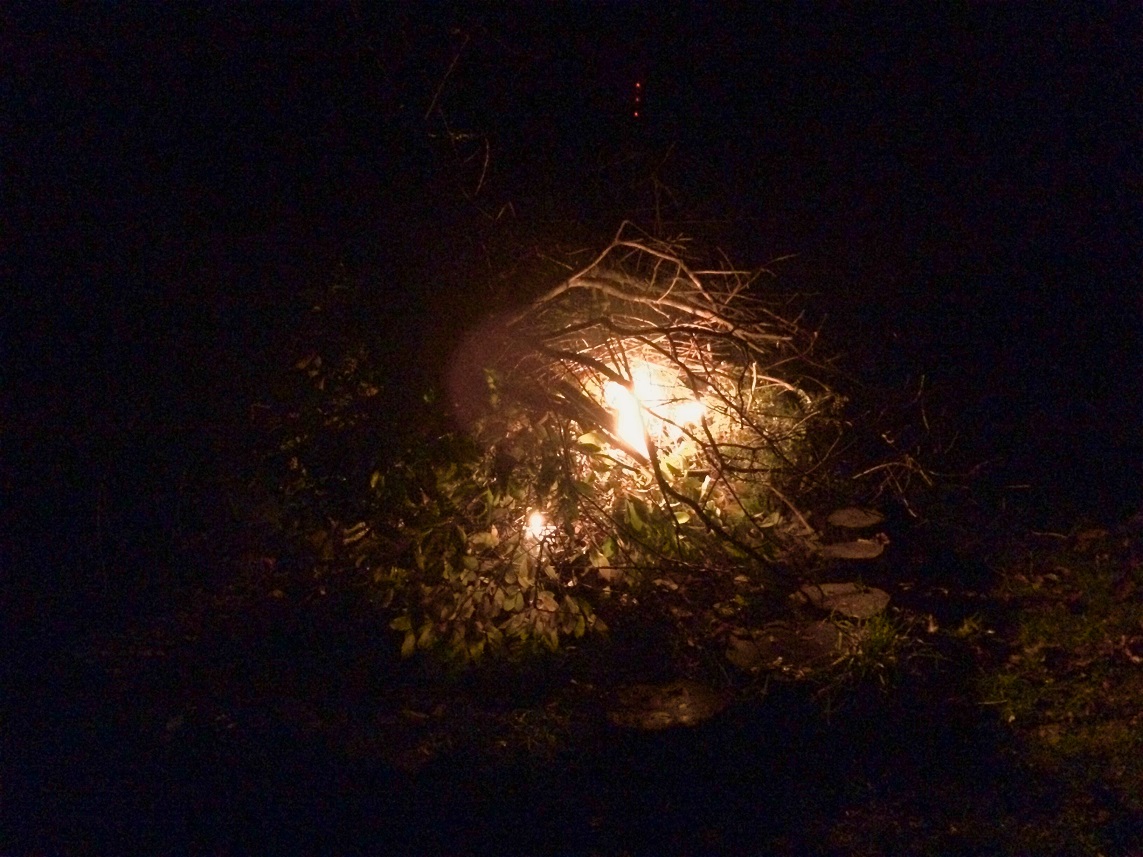 |
|
Valley View
(Daniel
Greening / Alistair Billington)
|
| |
|
|
|
| |
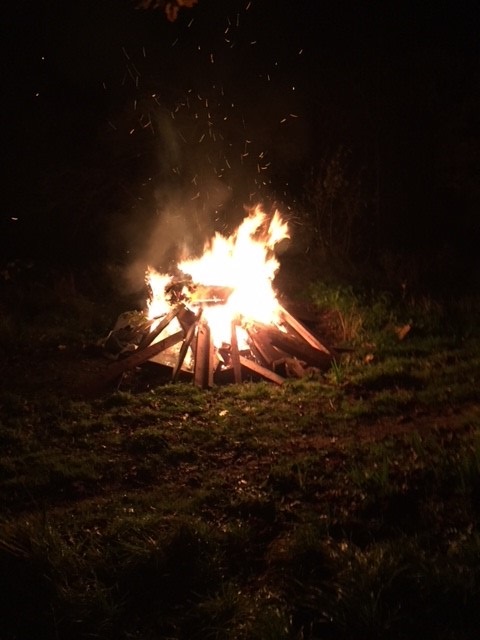 |
|
Cornhill
(Merv
Edgecombe) |
| |
|
|
|
| |
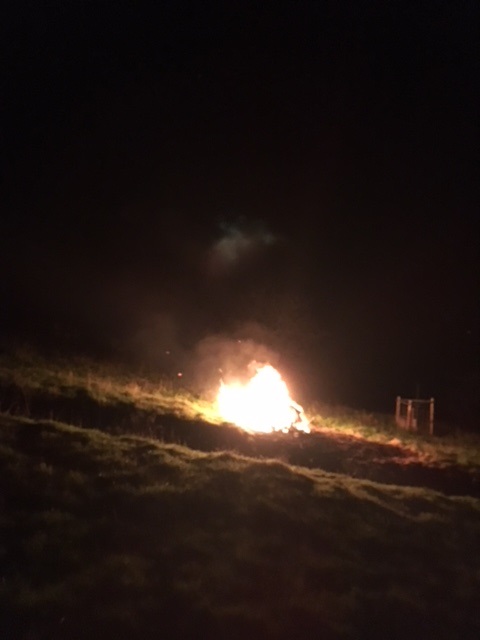 |
|
Panshayne
(Phil
& Serena Kerr) |
| |
|
|
|
| |
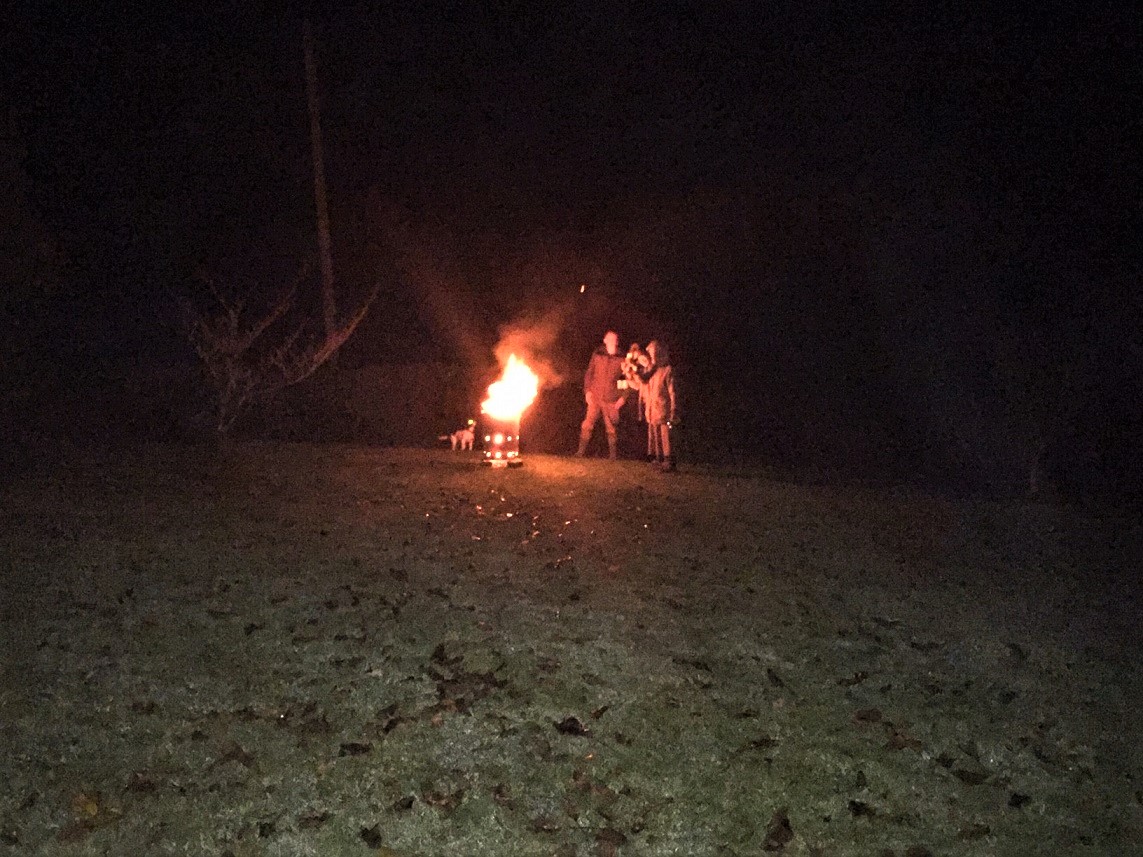 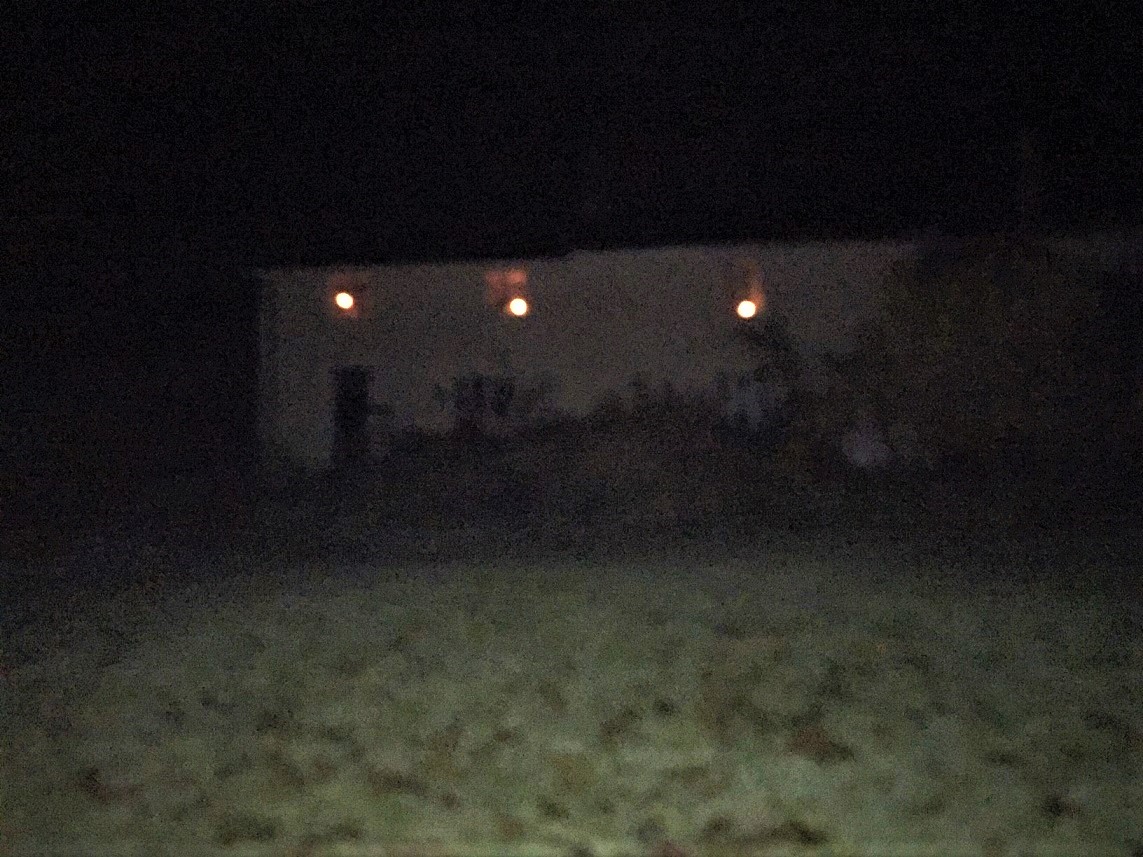 |
|
Beacon Farm Beacon including candles in
the windows
(Miranda Gudenian / Maggie Tomkinson) |
| |
|
|
|
| |
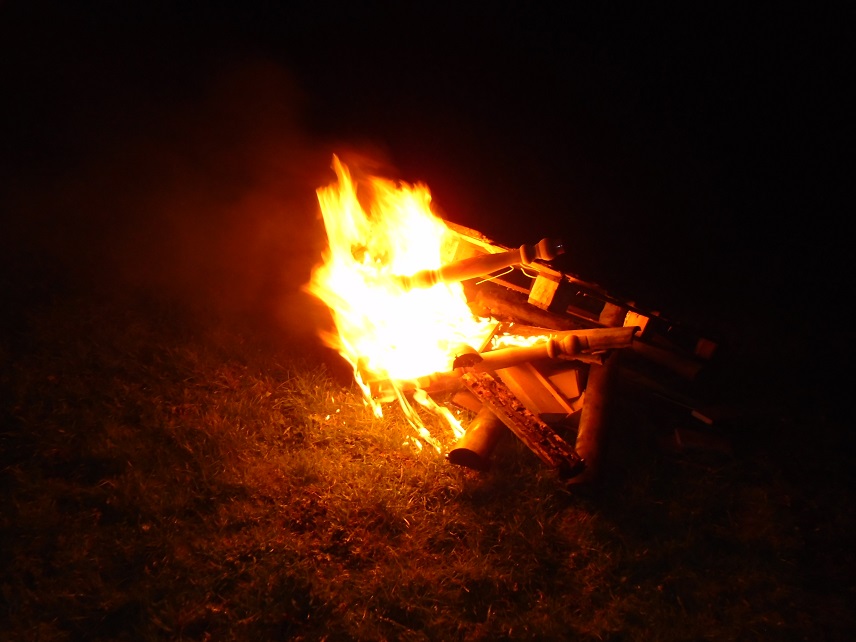 |
|
Four Elms
(Thelma Clarke & Nick
Randle)
Dedicated to Tommy
Batten. Also visible from Stock House
where Walter Tom Hawkins' family lived |
| |
|
|
|
|

